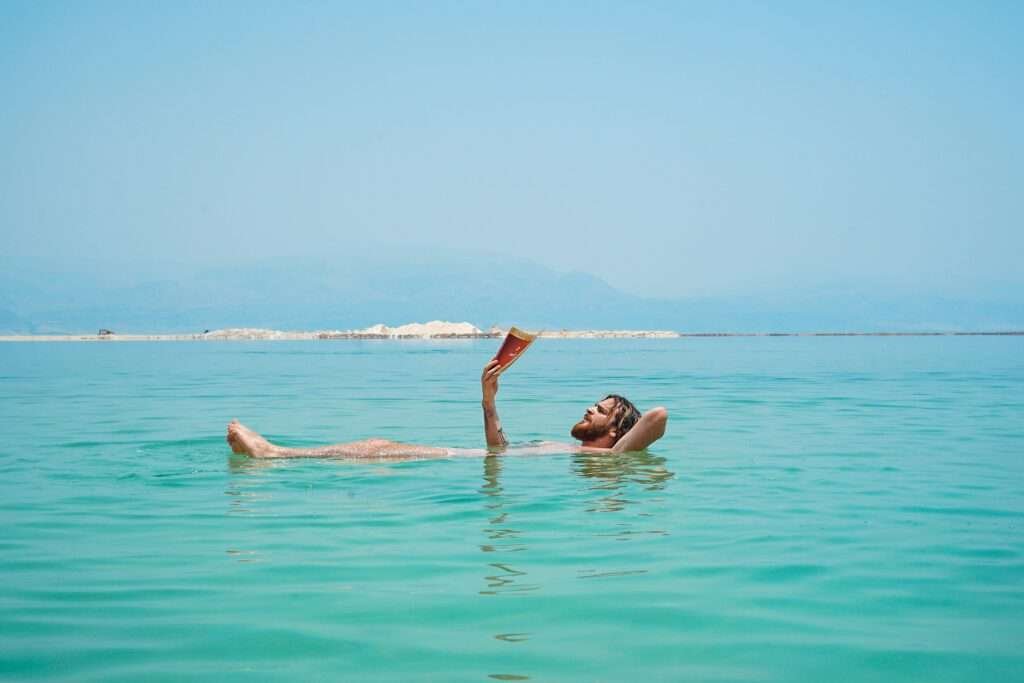Why People Float in the Dead Sea (and How It Works)
It’s the science of buoyancy applied to the world’s densest large lake. With salinity around ≈34% (about 340 g/L), the Dead Sea’s water reaches a density near 1.24 kg/L—about 21% denser than seawater—creating a strong upward push that lets people float effortlessly. As of 2025, these values remain widely reported by major scientific and government sources.
The Simple Idea: Why People Float Here
The key is density: the Dead Sea’s water is so packed with dissolved salts that each liter of water weighs more than a liter of normal seawater. When you get in, you displace a volume of this heavy water. The upward buoyant force equals the weight of the water you push aside; because that water is unusually heavy, the upward force is unusually strong. In short, the water “pushes up” harder than in freshwater or the ocean.
In physics terms (no equations needed), your average body density is close to plain water. Add air in your lungs and you’re typically a bit less dense than freshwater. In the ocean, most people can float if they inhale and relax. In the Dead Sea, the density jump is so big that nearly everyone floats without trying. For background on how salinity sets seawater density, see this NOAA JetStream explainer on seawater salinity.

The unique feature in one line
The unique feature that allows people to float effortlessly is the Dead Sea’s exceptionally high salinity (≈34%), which raises water density to ~1.24 kg/L—far above the ocean—so the buoyant force easily exceeds your weight in water.
Archimedes’ principle in everyday words
If the water around you is denser, the “push-up” from the water is stronger. In the Dead Sea, the push is strong enough that you don’t need to tread water. Think of it like sitting on a firm beanbag instead of a soft one: the firmer (denser) it is, the more it supports you.
| Concept | Plain-English Take |
|---|---|
| Buoyancy | Water pushes up on you as hard as the weight of the water you move out of the way. |
| Density | Heavier water per liter = stronger upward push. Dead Sea water is much heavier per liter than seawater. |
Salty by Design: What Makes the Dead Sea So Dense
The Dead Sea is a closed basin: rivers (mainly the Jordan) bring in water and dissolved minerals, but there’s no outlet to the ocean. Under hot, dry desert air, enormous evaporation leaves the water behind but removes pure H2O, concentrating salts year after year. That’s why the lake is hyper-salty compared with the open ocean. A concise overview of typical ocean salinity (about 35 g/L or 3.5%) is provided by NOAA JetStream; by contrast, observational reports for the Dead Sea cluster near ≈340 g/L (34%). Government and lab studies also document densities around ~1.24 kg/L. See, for example, an Israel Geological Survey report summarizing salinity ≈340 g/L and density ≈1.24 kg/L (Gavrieli et al., 2011).
Beyond sheer amount of salt, the mix matters. Dead Sea brine is unusually rich in magnesium and calcium chlorides, with very high chloride + bromide among the anions. Representative surface-water ion concentrations commonly cited are roughly: Mg ≈ 46 g/L, Na ≈ 37 g/L, Ca ≈ 18 g/L, K ≈ 8 g/L, and Cl⁻ + Br⁻ ≈ 230 g/L. Composition varies with depth, year, and flooding events, but the pattern—magnesium-rich, chloride-dominant—stays consistent in government and research summaries. See recent chemistry reports from the Geological Survey of Israel (2005–2015) and related scientific literature.
Geography & climate: a “salt trap”
Sitting in a deep desert depression about 31 mi (50 km) long, the Dead Sea loses more water to evaporation than it gains from rivers and rain. Without an outlet, salts concentrate. Occasional floods can temporarily form lighter freshwater layers on top, but the dense brine remains, keeping the overall buoyancy high.
Mineral mix that boosts density
Magnesium chloride and calcium chloride pack more “mass per ion” into the water than sodium chloride alone. That helps explain why the Dead Sea’s density outpaces even other salty lakes. For context on other hypersaline waters, compare NASA’s note that Great Salt Lake varies roughly 5–27% salinity depending on arm and level (NASA Earth Observatory).
Numbers That Make You Float (with a Comparison Table)
Here are typical headline numbers that explain the “effortless” float. Values vary with temperature and depth; these are order-of-magnitude figures from widely cited sources as of 2025.
| Body of Water | Typical Salinity | Density (kg/L) | Density (lb/ft³) | Float Likelihood |
|---|---|---|---|---|
| Freshwater (lakes/rivers) | <0.5 g/L (<0.05%) | ≈1.000 | ≈62.4 | Mixed; many sink if exhaling |
| Average Ocean | ≈35 g/L (3.5%) | ≈1.025 | ≈64.0 | Most float if relaxed/inhaling |
| Great Salt Lake (range) | ≈50–270 g/L (5–27%) | ≈1.05–1.20 | ≈65.6–74.9 | Usually easy to float at high end |
| Dead Sea (surface) | ≈340 g/L (34%) | ≈1.24 | ≈77.4 | Nearly everyone floats effortlessly |
Notes: Ocean salinity ≈33–37 g/L is summarized by NOAA; Great Salt Lake ranges and Dead Sea values are reported by NASA Earth Observatory and Israel Geological Survey/peer-reviewed sources cited in the references. Compared with seawater, Dead Sea water is ≈21% denser; compared with freshwater, ≈24% denser.
How to Float Effortlessly and Safely (Step-by-Step)
Floating is easy, but do it right for comfort and safety. First, wade in slowly until the water reaches your thighs. Turn your back to open water, sit down gently, and let your legs rise. Keep your head back and ears near the surface—your body will naturally find a stable “reclining chair” position. Breathe normally; deep, calm breaths add a bit of extra lift. If you feel yourself tipping, spread your arms and legs wide to increase stability.
Protect your eyes and mouth. The brine stings intensely. Do not dive or splash; keep your face dry, and avoid shaving or open cuts before entering. Wear water shoes to guard against sharp salt crystals. Bring fresh water to rinse off immediately after. Salty water dries fast in desert air, so apply moisturizer later to prevent skin irritation. Local operators post rules—follow them. The Dead Sea’s buoyancy makes swimming strokes awkward; treat it like floating, not lap swimming. For the ocean vs hypersaline contrast and why buoyancy can even make movement tricky, see NOAA’s short note on Dead Sea buoyancy in its learning pages.
Posture, breathing, and balance
Think “starfish recline”: arms out, heels near the surface, chin up. Small, slow breaths help you stay steady. If your feet pop too high, bend your knees slightly or scull gently with hands to level out.
Safety do’s and don’ts on site
Do check warnings about sinkholes and closed beaches; shorelines move as lake level changes. Don’t enter during dust storms or lightning. Do bring drinking water and a hat—the shore sits deep in a hot basin. Don’t spend long periods without shade; rest breaks are smart.
Does Everyone Float? Factors that Change Buoyancy
Almost everyone floats in the Dead Sea, but the exact “feel” varies. People with higher body fat tend to be less dense and feel even more lift; very muscular swimmers (denser) still float here because the water density is so high. Lung inflation matters: a deep inhale decreases your overall body density and adds noticeable lift. Medical studies confirm how lung inflation changes tissue density, while textbooks on buoyancy explain why volume and density control floating.
Water conditions matter too. Warm surface layers can reduce density slightly; rare flood events can create a thin, temporary freshwater layer on top of the brine, reducing buoyancy right at the surface until mixing restores the usual density. Researchers note the Dead Sea’s brine is so dense that it stratifies easily after heavy rains; this layering can persist for weeks depending on weather.
FAQ
What unique feature does the Dead Sea have that allows people to float effortlessly?
Its hyper-salinity (≈34% by weight) raises water density to ~1.24 kg/L, roughly 21% denser than seawater. That extra density creates a stronger buoyant force, so you float with almost no effort.
Is it really “ten times saltier” than the ocean?
Ocean salinity averages about 3.5% (35 g/L). The Dead Sea is around 34%, so “about ten times” is a handy rule of thumb. Exact values change with depth, season, and long-term lake-level trends.
Can I swim normally in the Dead Sea?
Not really—your legs ride high and strokes feel awkward. Treat it as a gentle float. Keep your face dry and avoid splashing; bring fresh water to rinse your skin and eyes if needed.
What Did We Learn Today?
- The Dead Sea’s water is ~34% salt (≈340 g/L), far above ocean water (~35 g/L).
- Its density is about 1.24 kg/L (≈77.4 lb/ft³), ≈21% denser than seawater.
- Buoyancy equals the weight of displaced water; denser water = stronger lift.
- Magnesium- and calcium-rich chlorides boost density beyond simple table salt.
- Nearly everyone can float here; posture, breathing, and eye safety matter.

